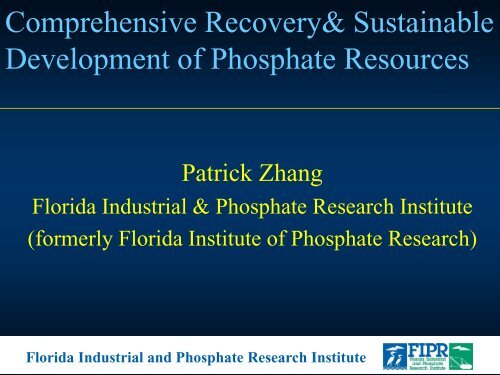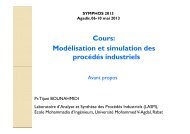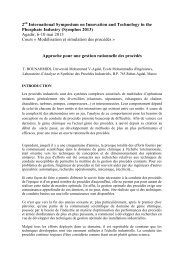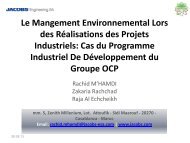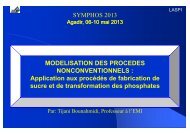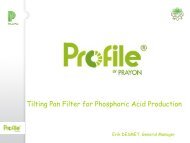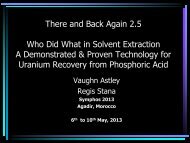Comprehensive Recovery& Sustainable Development of Phosphate Resources
Patrick ZHANG.pdf
Patrick ZHANG.pdf
You also want an ePaper? Increase the reach of your titles
YUMPU automatically turns print PDFs into web optimized ePapers that Google loves.
<strong>Comprehensive</strong> Recovery& <strong>Sustainable</strong><br />
<strong>Development</strong> <strong>of</strong> <strong>Phosphate</strong> <strong>Resources</strong><br />
Patrick Zhang<br />
Florida Industrial & <strong>Phosphate</strong> Research Institute<br />
(formerly Florida Institute <strong>of</strong> <strong>Phosphate</strong> Research)<br />
Florida Industrial and <strong>Phosphate</strong> Research Institute
<strong>Phosphate</strong> Is an Energy Mineral<br />
• Well known fact: phosphate is a crop nutrient<br />
(providing energy for plants) mineral, key to<br />
production <strong>of</strong> food that provides energy for<br />
mankind<br />
• Less known truth: phosphate is also a energy<br />
mineral<br />
– Uranium (nuclear energy)<br />
– Rare earths (green energy)<br />
– Thorium (green nuclear energy)<br />
<strong>Phosphate</strong> could power the world!
Summary <strong>of</strong> World <strong>Phosphate</strong> Mining<br />
• Production reaching 200 million tons/year<br />
• Surface mining dominates<br />
• Washing is common, producing slime<br />
• Flotation is the major technology for upgrading<br />
• Dolomite (carbonate) is a worldwide problem<br />
• Permitting is becoming a global challenge<br />
Florida Industrial and <strong>Phosphate</strong> Research Institute
Three <strong>Sustainable</strong> <strong>Development</strong><br />
Approaches<br />
• Improving P 2 O 5 recovery<br />
• Waste treatment and utilization<br />
• <strong>Comprehensive</strong> recovery<br />
Florida Industrial and <strong>Phosphate</strong> Research Institute
Improving <strong>Phosphate</strong> Recovery<br />
• Improving P 2 O 5 recovery in the mining process<br />
Current mining recovery
Remote LIBS (Laser-Induced<br />
Breakdown Spectroscopy) Analyzer<br />
• Distant (5-25 m)<br />
real-time chemical<br />
analysis <strong>of</strong><br />
phosphate<br />
minerals<br />
• Correlation<br />
coefficient <strong>of</strong> R 2 =<br />
0.915 for P 2 O 5 .<br />
Florida Industrial and <strong>Phosphate</strong> Research Institute
Types <strong>of</strong> <strong>Phosphate</strong> Ores Based on<br />
Beneficiation Difficulty
Direct-Reverse Flotation <strong>of</strong><br />
Carbonaceous <strong>Phosphate</strong> Ores<br />
Feed with -0.074mm fraction accounting for 98.4%<br />
Na2CO3, 5.0Kg/t<br />
Na2SiO3 , 4.0Kg/t<br />
YP 2-1<br />
, 1.8Kg/t<br />
YP 1<br />
, 0.3Kg/t<br />
YP 2-1<br />
, 0.9Kg/t<br />
YP 2-1<br />
,0.5Kg/t<br />
H 2<br />
SO 4<br />
, 6.4Kg/t<br />
YP 2-3<br />
, 0.5Kg/t<br />
Concentrate<br />
Carbonate Tailings<br />
Silicate Tailings
Utilization <strong>of</strong> Low-grade <strong>Phosphate</strong>: The<br />
Improved “Hard” Process
Advantages <strong>of</strong> the Improved “Hard”<br />
Process<br />
• Increased overall phosphate recovery<br />
• Use <strong>of</strong> low-grade rock<br />
• No clay ponds<br />
• No PG generation<br />
Florida Industrial and <strong>Phosphate</strong> Research Institute
Major Wastes Generated by the<br />
<strong>Phosphate</strong> Industry<br />
• Slime<br />
• Phosphogypsum<br />
• Slags<br />
Florida Industrial and <strong>Phosphate</strong> Research Institute
Phosphatic Clay Statistics - Florida<br />
• About a ton <strong>of</strong> clay generated for each ton <strong>of</strong> rock<br />
• Nearly 100,000 tons produced per day, disposed <strong>of</strong><br />
as 3% solids slurry<br />
• Over 3 million tons <strong>of</strong> slurry per day<br />
• 30-40% mined lands used as clay settling areas<br />
Florida<br />
Florida<br />
Institute<br />
Industrial<br />
<strong>of</strong> <strong>Phosphate</strong><br />
and <strong>Phosphate</strong><br />
Research<br />
Research Institute
Basic Properties <strong>of</strong> Florida<br />
Phosphatic Clays<br />
• Averaging 9% P 2 O 5<br />
• Containing ±50% clay minerals<br />
• Containing up to 40% <strong>of</strong> the REE in phosphate ore<br />
• Containing about 30% <strong>of</strong> the U in phosphate ore<br />
• Extremely fine, 90% below 20microns<br />
Florida<br />
Florida<br />
Institute<br />
Industrial<br />
<strong>of</strong> <strong>Phosphate</strong><br />
and <strong>Phosphate</strong><br />
Research<br />
Research Institute
Potential Uses <strong>of</strong> Waste Clay<br />
• Tile<br />
• Light weight aggregates<br />
• Polymer modified waste clay as concrete additive<br />
to increase ductility and strength<br />
• Recovery <strong>of</strong> P, U and rare earths<br />
Florida Industrial and <strong>Phosphate</strong> Research Institute<br />
Florida Institute <strong>of</strong> <strong>Phosphate</strong> Research
“Wet Process” Phosphoric Acid<br />
Production and Phosphogypsum (PG)<br />
Ca 10 F 2 (PO 4 ) 6 + 10H 2 SO 4 + 10nH 2 O →<br />
10CaSO 4 •nH 2 O (PG) + 6H3PO4 + 2HF<br />
• Di-hydrate process, n=2<br />
• Hemi-hydrate process, n=1/2<br />
• Hemi-Di-hydrate process, n=2<br />
Florida Industrial and <strong>Phosphate</strong> Research Institute
World Phosphogypsum Statistics<br />
• Calculation basis:<br />
o Annual rock production 200 Mt<br />
o 70% <strong>of</strong> the rock is used for wet acid production<br />
o 4.5tons <strong>of</strong> PG produced per ton <strong>of</strong> P2O5 produced<br />
o P2O5 in rock averaging 30%<br />
• Annual world PG production 189 Mt<br />
Florida Industrial and <strong>Phosphate</strong> Research Institute
Problems with Phosphogypsum Stacks<br />
• Spills <strong>of</strong> process water on top <strong>of</strong> PG stacks<br />
• Possible groundwater contamination<br />
• Occupy a significant amount <strong>of</strong> land<br />
• Can be located in highly sensitive,<br />
increasingly populated areas<br />
• Costs <strong>of</strong> opening, operating and closing<br />
stacks<br />
Florida Industrial and <strong>Phosphate</strong> Research Institute
Research Has Been Conducted on More<br />
Than 50 Uses <strong>of</strong> Phosphogypsum<br />
Landfill Chemical Agriculture Construction<br />
Waste destruction<br />
Energy generation<br />
S recovery<br />
(NH 4 ) 2 SO 4<br />
CaO<br />
Sodic soil treatment<br />
Acidic soil treatment<br />
Ca source<br />
S source<br />
P source<br />
Mg source<br />
Road base<br />
Cement<br />
Building blocks<br />
Wall boards<br />
Brick<br />
Sand substitute<br />
Aggregate substitute<br />
Florida Industrial and <strong>Phosphate</strong> Research Institute
Successful PG Uses in Agriculture<br />
• The exchangeable Ca in PG can ameliorate<br />
subsoil acidity and Al 3+ toxicity and reclaim<br />
sodic soils. PG is also known for its capability <strong>of</strong><br />
improving soil structure by flocculating clays in<br />
soil.<br />
Florida Industrial and <strong>Phosphate</strong> Research Institute
Successful PG Uses in Agriculture<br />
• PG contains nutrients Ca, S and P<br />
• PG enhances root growth thus helping plants<br />
absorb other nutrients, especially<br />
• Dissolution <strong>of</strong> PG in soil provides essential<br />
electrolytes to maintain hydraulic conductivities<br />
and increase infiltration rates thus preventing<br />
crusting and reducing erosion.<br />
Florida Industrial and <strong>Phosphate</strong> Research Institute
Successful PG Uses in Agriculture<br />
• Application <strong>of</strong> 500 lbs PG per acre tripled<br />
NCS31 peanut yield in Georgia, USA<br />
• Use <strong>of</strong> PG more than doubled apple yield while<br />
increasing calcium content in Brazil<br />
• Application <strong>of</strong> 176 lbs PG per acre nearly<br />
doubled crimson clover yield in Florida, USA<br />
• Application <strong>of</strong> 4.5 ton PG per hectare on a sodic<br />
soil increased cotton yield by at least 40% in<br />
Kazakhstan<br />
Florida Industrial and <strong>Phosphate</strong> Research Institute
World Potential for Agricultural<br />
Phosphogypsum Consumption<br />
• World crop area is >4.5 billion hectares<br />
• At an application rate <strong>of</strong> 0.1 ton/hectare/yr,<br />
450 million tons/yr could be consumed<br />
• Agriculture has the potential to consume all<br />
the PG the phosphate industry produces<br />
Florida Industrial and <strong>Phosphate</strong> Research Institute
PG Use in Construction in China<br />
• Cement retarder<br />
• PG board with paper cover<br />
• PG blocks<br />
• Bricks
PG Use in Roads<br />
• PG makes a superior road base at a significantly<br />
lower cost than conventional road base materials<br />
• PG dries fast after rain falls thus down time in<br />
road construction<br />
• PG roads get better with aging<br />
Florida Industrial and <strong>Phosphate</strong> Research Institute
PG Use in Roads – Cost Comparison<br />
Item<br />
Cost, $/mile<br />
Tanner Road Windy Hill<br />
Parrish Road<br />
Road with PG<br />
Materials 35,009 47,719 0<br />
Labor 28,912 38,408 9,511<br />
Equipment 34,418 43,193 13,974<br />
Total 98,339 129,320 23,485<br />
Florida Industrial and <strong>Phosphate</strong> Research Institute
PG Use as a Chemical Raw Material<br />
Industrial Operations in China<br />
• Sulfur recovery<br />
• Ammonium sulfate production: Wengfu Group’s<br />
250,000 tons plant consuming 50% <strong>of</strong> waste CO2<br />
gas from their ammonia plant ammonium sulfate<br />
per year<br />
Florida Industrial and <strong>Phosphate</strong> Research Institute
Use <strong>of</strong> Phosphogypsum -Challenges<br />
• Low product values<br />
• Transportation costs<br />
• Sulfur price flocculation<br />
• Government regulations and public perception<br />
with regard to radiation (particularly in Florida)
Use <strong>of</strong> Phosphogypsum - Opportunities<br />
• Promotion by various entities, IAEA, FIPR,<br />
Aleffgroup, Wengfu Group, GCT, OCP, Vale,<br />
Paradeep…<br />
• Large PG use plants have been built recently in<br />
China, and some may come on line soon in India<br />
and Brazil<br />
• Government efforts<br />
– China’s new plan calling for 30% use <strong>of</strong> PG by 2025<br />
– Guizhou Province set the goal for zero PG<br />
accumulation by year 2025
Production <strong>of</strong> Ammonium <strong>Phosphate</strong>s<br />
Demands for Phosphoric Acid<br />
• The first wet-acid plant built in Germany 1870<br />
• The first wet-acid plant in the U.S. in 1890<br />
• Thermal processes (using either blast furnace or<br />
electric furnace) dominated during the early<br />
phosphate booming years<br />
• Since 1950, the wet acid process has quickly<br />
overtaken the thermal method<br />
• Today only about 5% <strong>of</strong> the world phosphate rock<br />
is consumed by the thermal process
World <strong>Phosphate</strong> Rock Consumption<br />
by Category<br />
10%<br />
0.50%<br />
5%<br />
Wet acid<br />
13.50%<br />
SSP<br />
Others (animal feed, FMP,<br />
MKP, TSP, NPK, NP)<br />
71%<br />
Thermal phosphorus<br />
Direct application
“Wet Process” Phosphoric Acid<br />
Production and Phosphogypsum (PG)<br />
(fluorapatite) Ca 10 F 2 (PO 4 ) 6 + 10H 2 SO 4 + 10nH 2 O<br />
→ 10CaSO 4 •nH 2 O (PG) + 6H3PO4 + 2HF<br />
• Di-hydrate process, n=2<br />
• Hemi-hydrate process, n=1/2<br />
• Anhydrite, n=0<br />
Florida Industrial and <strong>Phosphate</strong> Research Institute
<strong>Comprehensive</strong> Recovery: Treating<br />
<strong>Phosphate</strong> as an Energy Mineral<br />
• Well known fact: phosphate is a crop nutrient<br />
(providing energy for plants) mineral, key to<br />
production <strong>of</strong> food that provides energy for<br />
mankind<br />
• Less known truth: phosphate is also a energy<br />
mineral<br />
– Uranium (nuclear energy)<br />
– Rare earths (green energy)<br />
– Thorium (green nuclear energy)<br />
<strong>Phosphate</strong> powers the world!
Average Uranium and Thorium Contents<br />
(ppm) in Selected <strong>Phosphate</strong> Ores<br />
Sample No. <strong>of</strong> sample U Th<br />
Florida, USA pebble, 1926-1935 11 208 14<br />
Florida, USA pebble, 1946-1955 14 148 13<br />
Florida, USA pebble, 1959-1964 12 127 17<br />
Florida, USA Pebble, 1994 3 95 --<br />
North Carolina, USA, 1957-1964 3 79 9<br />
Utah, USA, 1936-1961 9 128 7<br />
Idaho, USA 5 151 8<br />
Peru, washed rock, 1961-1964 7 106 8<br />
Morocco, 1937-1943 5 141 8<br />
Tunisia,1927-1955 6 48 23<br />
Jordan, 1956-1963 6 48 0<br />
Egypt, 1936-1937 6 122 6<br />
Senegal 6 107 17
Uranium in Selected <strong>Phosphate</strong> Rock<br />
and Phosphoric Acid Samples (ppm)<br />
Location U 3 O 8 in Rock U 3 O 8 in Phosphoric<br />
Acid (30% P 2 O 5 )<br />
Algeria 110-140 130<br />
Brazil 80 80<br />
Israel 50-150 165<br />
Jordan 120-150 165<br />
Morocco 90-140 140<br />
Tunisia 50-100 80<br />
Florida 150-180 190<br />
Florida Industrial and <strong>Phosphate</strong> Research Institute
Uranium in <strong>Phosphate</strong>: Basic Facts<br />
• Concentration ranging from 50 to 200 ppm,<br />
averaging +100 ppm<br />
• Worldwide annual U unrecovered from<br />
phosphate totaling 18 million kg (based on<br />
180Mt rock production)<br />
• Worldwide total U resources toping 29 billion kg<br />
(based on total phosphate resources <strong>of</strong> 290<br />
billion tons)<br />
Florida Industrial and <strong>Phosphate</strong> Research Institute
Uranium in <strong>Phosphate</strong> Accounting for<br />
88% <strong>of</strong> the World’s Unconventional U<br />
Unconventional U<br />
Lignite, 2%<br />
Black Shale, 8%<br />
<strong>Phosphate</strong>, 88%<br />
Other, 2%<br />
Source: Harikrishnan Tulsidas, IAEA, 2012
Form <strong>of</strong> Uranium in <strong>Phosphate</strong> Rock<br />
• Normally 65% as U 4+ , & 35% as U 6+<br />
• U 4+ exists in isomorphous substitution for Ca<br />
• U 6+ is held by chemisorbtion on surface as<br />
UO 2 .HPO 4<br />
• In igneous phosphate U could also be associated<br />
with thorium (232Th) and rare earths<br />
Florida Industrial and <strong>Phosphate</strong> Research Institute
Fate <strong>of</strong> Uranium in the Wet Acid &<br />
Fertilizer Manufacturing Processes<br />
• 80-90% in phosphoric acid<br />
• 10-20% in phosphogypsum (PG)<br />
– About 10% in dihydrate PG<br />
– Up to 20% in hemihydrate PG<br />
• Nearly all the U in the acid ends up in fertilizers<br />
Florida Industrial and <strong>Phosphate</strong> Research Institute
Recovery <strong>of</strong> Uranium from Phos. Acid<br />
• Industrially proven in numerous plants and twice<br />
in the history<br />
• No mining costs<br />
• Easy to permit<br />
• Saving a resource otherwise forever lost<br />
• Other elements <strong>of</strong> value (Th and REE) can be<br />
recovered from the same liquid<br />
Florida Industrial and <strong>Phosphate</strong> Research Institute
Techniques for Uranium Extraction<br />
from Phosphoric Acid<br />
• Solvent extraction (SX), the industrially proven<br />
process<br />
• Ion exchange (IX), the intensively investigated<br />
method with many promises<br />
• Precipitation, the “abandoned” process?<br />
Florida Industrial and <strong>Phosphate</strong> Research Institute
Solvent Extraction Based Technologies<br />
for U Recovery from Phosphoric Acid<br />
in Sulfate Media<br />
• DEPA-TOPO (also DEHPA-TOPO, D2EHPA-<br />
TOPO) uses di(2-ethylhexyl) phosphoric acid<br />
and trioctyl phosphine oxide as extractants<br />
(ORNL process)<br />
• OPAP uses octyl phenyl acid phosphate as<br />
extractant (ORNL process)<br />
• OPPA uses octyl pyro phosphoric acid as<br />
extractant (Dow process)
Three Major SX Systems<br />
Process Extractant Formular<br />
OPPA<br />
D2EHPA/TOPO<br />
DEPA/TOPO<br />
Octyl pyrophosphoric acid<br />
Dissolving P 2 O 5 in octyl<br />
alcohol in the absence <strong>of</strong><br />
moisture and below 15 o C<br />
A mixture <strong>of</strong> di(2-thylhexyl)<br />
phosphoric acid and<br />
trioctyl phosphine oxide,<br />
{H3C(CH2)7}3-P=O<br />
where R is CH3.(CH2)6.CH2-<br />
OPAP process<br />
A mixture <strong>of</strong> mono and<br />
di-octylphenyl<br />
phosphoric acids and tributyl<br />
phosphate, (C4H9O)3-P=O
DEPA/TOPO Based Process:<br />
Pretreatment<br />
• Cooling<br />
‣ To precipitateNa 2 SiF 6 and CaSO 4 and improve SX efficiency<br />
• Flocculation-filtration<br />
‣ To remove precipitates<br />
• Absorption with activated carbon or sand<br />
‣ To remove organics<br />
• Oxidation (with H 2 O 2 , O 2 , or Fe +2 )<br />
‣ To convert all U to hexavalent form<br />
Florida Industrial and <strong>Phosphate</strong> Research Institute
DEPA/TOPO Based Process:<br />
Two-cycle Extraction<br />
• First cycle<br />
‣ In a counter-current mixer/settler system, clarified acid is<br />
contacted with DEPA-TOPO solvent dissolved in kerosene; U<br />
is transferred to the organic phase. Lean phosphoric acid is<br />
returned to the phosphoric acid plant.<br />
• First cycle stripping<br />
‣ The organic phase containing uranium in the U 6+ state is<br />
reduced to the U 4+ state; it is then contacted with more<br />
concentrated phosphoric acid in a second mixer/settler system.<br />
Here the U is stripped from the relatively large volume <strong>of</strong><br />
organic solvent and transferred to the smaller volume <strong>of</strong> a<br />
stripping acid.
DEPA/TOPO Based Process:<br />
Two-cycle Extraction<br />
• Second cycle extraction<br />
‣ The loaded primary stripping acid is oxidized to convert uranium<br />
back to the U 6+ state. The strip acid is then contacted with DEPA-<br />
TOPO solvent in a mixer/settler system, where concentrated U is<br />
transferred to the solvent phase and further concentration takes<br />
place to form “pregnant secondary organic”.<br />
• Second cycle stripping<br />
‣ The pregnant secondary organic containing the U is contacted<br />
with an alkaline solution in a mixer/settler system. Here the U<br />
is stripped from the organic solvent and transferred to the<br />
alkaline solution in a more concentrated form. The secondary<br />
strip solution is treated to neutralize the alkali and produce an<br />
acidic uranium solution.
DEPA/TOPO Based Process:<br />
Oxidizing & Refining<br />
• The acid uranium solution is oxidized:<br />
− with hydrogen peroxide to form uranyl peroxide UO4·nH2O<br />
− with ammonia to form ammonium diuranate (ADU), (NH 4 ) 2 U 2 O 7<br />
− with to ammonium carbonate (or ammonia+CO 2 ) to form<br />
ammonium uranyl tricarbonate (AUT), (NH 4 ) 4 U 2 O 7 (CO 3 ) 3<br />
• Thicken, wash, dry, and calcine the above<br />
products to produce U 3 O 8 – yellow cake<br />
Florida Industrial and <strong>Phosphate</strong> Research Institute
Second Wave Uranium Recovery Plants<br />
Acid<br />
Producer<br />
Farmland<br />
Uranium<br />
Producer<br />
Wyoming<br />
Minerals<br />
Freeport<br />
Location<br />
Capacity<br />
P 2 O 5<br />
(tons/year)<br />
Capacity<br />
U 3 O 8<br />
(lbs/year)<br />
Pierce, FL 450,000 400,000<br />
Process<br />
WMC, DEPA-<br />
TOPO<br />
Freeport<br />
Minerals Co. Uncle Sam, LA 675,000 690,000 FMC, DEPA-<br />
TOPO<br />
Agrico<br />
Freeport Donaldsonville,<br />
FMC,<br />
360,000 420,000<br />
Minerals Co. LA<br />
DEPA-TOPO<br />
IMC IMC New Wales, FL 1,000,000 800,000<br />
IMC, DEPA-<br />
TOPO<br />
CF Industries IMC Bartow, FL 720,000 600,000<br />
IMC, DEPA-<br />
TOPO<br />
CF Industries IMC Plant City, FL 680,000 600,000<br />
IMC, DEPA-<br />
TOPO<br />
W. R. Grace<br />
Uranium<br />
Recovery<br />
Operating<br />
Period<br />
1978 – 1981<br />
1978 - 1999<br />
1981 - 1998<br />
1980 - 1992<br />
1981 - 1985<br />
1980 - 1992<br />
Bartow, FL na 330,000 URC, OPAP 1976 – 1980<br />
Gardinier Gardinier East Tampa, FL 500,000 420,000 Gardinier, OPPA 1979 – 1982<br />
Western<br />
Coop.<br />
Fertilizer<br />
Earth<br />
Sciences<br />
Calgary, Alberta,<br />
Canada<br />
Chemie Rupel Umipray Purrs, Belgium 100,000 150,000<br />
144,000 120,000 ESI, OPAP 1981 – 1987<br />
IMC – Prayon,<br />
DEPA-TOPO<br />
1980 - 1998
Uranium Recovered from<br />
Phosphoric Acid in the USA<br />
Millions Kg <strong>of</strong> U3O8<br />
1.5<br />
1<br />
0.5<br />
0<br />
1978 1982 1986 1990 1994 1998<br />
.
U Recovery from Concentrated Phos.<br />
Acid from Hemihydrate Process<br />
• Solvent DEPHA + TOPO proved to be<br />
effective.<br />
• Both the technical and economic feasibility<br />
demonstrated for uranium recovery from<br />
hemihydrate acid (40-45% P 2 O 5 ) were<br />
demonstrated.<br />
Florida Industrial and <strong>Phosphate</strong> Research Institute
Solvent Extraction Based Technologies<br />
for U Recovery from Phosphoric Acid<br />
via Nitric Acid Digestion<br />
• Tributyl phosphate (TBP)<br />
• Tertiary amyl alcohol<br />
Florida Industrial and <strong>Phosphate</strong> Research Institute
Advantages <strong>of</strong> the Nitrate Route<br />
• No phosphogypsum problem<br />
• Suitable for in-situ or heap leaching <strong>of</strong> low<br />
grade phosphate ores<br />
• Better for REE recovery<br />
• More complete REE dissolution by nitric acid<br />
• Both extractants capable <strong>of</strong> picking up REE<br />
while extracting U<br />
Florida Industrial and <strong>Phosphate</strong> Research Institute
Recovery <strong>of</strong> Uranium from Phos. Acid<br />
Challenges<br />
• Fluctuating uranium prices<br />
• Unfavorable public perception and political<br />
atmosphere about nuclear power due to the<br />
accident in Japan<br />
• Industry fatigue<br />
• Industry becoming more risk averse<br />
Florida Industrial and <strong>Phosphate</strong> Research Institute
Recovery <strong>of</strong> Uranium from Phos. Acid<br />
Opportunities<br />
• Advances in technologies –ion exchange<br />
• IAEA’s UxP program<br />
• Resource utilization efficiency consideration<br />
• Nuclear energy tremendously appealing for<br />
curbing global warming<br />
• Simultaneous recovery <strong>of</strong> REE and Th<br />
Florida Industrial and <strong>Phosphate</strong> Research Institute
Recent/Current Efforts to Recover<br />
Uranium from Phos. Acid<br />
• Florida companies completed new feasibility<br />
study and plant design<br />
• OCP Group’s commercialization plans<br />
• Pilot testing program in Egypt<br />
• Pilot testing program in Tunisia<br />
• Urteck pilot testing<br />
• FIPR program in conjunction with the CMI<br />
• Joint efforts by K-Technologies & Kemworks
Egyptian Pilot Testing Program on<br />
Uranium Recovery from Phosphoric<br />
Acid<br />
• Capacity: 1 cubic meter <strong>of</strong> acid per hour<br />
• Has been conducted on and <strong>of</strong>f for 10 years<br />
USF Polytechnic - Florida Industrial and <strong>Phosphate</strong> Research Institute
Pretreatment Tanks<br />
Each tank can hold<br />
20 tons <strong>of</strong> acid<br />
Florida Industrial and <strong>Phosphate</strong> Research Institute
Acid Pre-treatment Columns<br />
Carbon columns<br />
are short, and sand<br />
columns are tall<br />
Florida Industrial and <strong>Phosphate</strong> Research Institute
First Cycle Extraction<br />
4 mixer-settlers for uranium<br />
extraction from pretreated<br />
phosphoric acid (with 60<br />
ppm uranium) using a<br />
mixture <strong>of</strong> 0.5 M D 2 EHPA &<br />
0.125 M TOPO in Kerosene .<br />
Acid flow rate: 1 m 3 /hr;<br />
organic flow rate: 330 L/hr.<br />
Florida Industrial and <strong>Phosphate</strong> Research Institute
First Cycle Stripping<br />
Three mixer-settlers for<br />
uranium stripping from<br />
loaded organic solvent using<br />
diluted pure phosphoric acid<br />
(36 % P 2 O 5 ) containing iron<br />
powder<br />
Florida Industrial and <strong>Phosphate</strong> Research Institute
Second Cycle Extraction/Stripping<br />
11 mixer-settlers: 4 for uranium<br />
extraction (0.3 M D 2 EHPA & 0.075<br />
M TOPO in kerosene) from diluted<br />
acid produced from the primary<br />
unit; 3 for organic scrubbing by<br />
using distilled water; 2 for uranium<br />
stripping by ammonium carbonate;<br />
finally 2 for washing stripped<br />
organic using sulfuric acid.<br />
Florida Industrial and <strong>Phosphate</strong> Research Institute
The Tunisia Pilot Plant for U Recovery<br />
A Lasting and High Pr<strong>of</strong>ile Program
Unique Features <strong>of</strong> the Tunisia Pilot<br />
Plant for U Recovery<br />
• Purification and concentration (from 40-56%<br />
P 2 O 5 ) <strong>of</strong> phosphoric acid<br />
• Use <strong>of</strong> columns for extraction instead <strong>of</strong><br />
mixer/settler
The Tunisia Pilot Plant for U Recovery<br />
Phosphoric Acid Purification
The Tunisia Pilot Plant for U Recovery<br />
Columns Are Used for Extraction
The Tunisia Pilot Plant for U Recovery<br />
Acid Pre-treatment and Purification
Recent R&D Efforts: Pilot Testing <strong>of</strong><br />
IX Technology by Urtek<br />
Florida Industrial and <strong>Phosphate</strong> Research Institute
Recent R&D Efforts: Pilot Testing <strong>of</strong><br />
IX Technology by Urtek<br />
Florida Industrial and <strong>Phosphate</strong> Research Institute
Recent R&D Efforts: Pilot Testing <strong>of</strong><br />
IX Technology by Urtek<br />
The portable demonstration plant was<br />
commissioned in May 2012 and operated in the<br />
United States during June to August 2012 on<br />
phosphoric acid streams from two fertilizer<br />
facilities.<br />
Florida Industrial and <strong>Phosphate</strong> Research Institute
Summary <strong>of</strong> Urtek Pilot Testing<br />
• Consistently high uranium recovery (> 90%)<br />
• No crud formation<br />
• Reagent consumptions within expected range<br />
• Purification and concentration <strong>of</strong> uranium<br />
achieved without significant uranium losses<br />
• Phosphoric acid chemistry unchanged except for<br />
the removal <strong>of</strong> uranium and other impurities<br />
Florida Industrial and <strong>Phosphate</strong> Research Institute
Urtek Pre-feasibility Study: Base Case<br />
• 1M short ton <strong>of</strong> P 2 O 5 phosphate facility<br />
• 880,000 lbs <strong>of</strong> uranium per annum<br />
Florida Industrial and <strong>Phosphate</strong> Research Institute
Urtek Pre-feasibility Study: Cost<br />
Numbers<br />
• Cash operating costs: $18/lb <strong>of</strong> U3O8<br />
• Consumables: $6.70/lb <strong>of</strong> U3O8<br />
• Labor: $1.10/lb <strong>of</strong> U3O8<br />
• Maintenance: $3.20/lb <strong>of</strong> U3O8<br />
• Misc. $4.90/lb <strong>of</strong> U3O8<br />
• Contingency $1.50/lb <strong>of</strong> U3O8<br />
• Capital cost: $156 million<br />
Florida Industrial and <strong>Phosphate</strong> Research Institute
REE in World <strong>Phosphate</strong> Rock<br />
Lanthanide Content (Krea and Khalaf, 2000)<br />
Rock Source Ln 2 O 3 (%)<br />
Kola, Russia 0.84-0.88<br />
Florida pebble 0.29<br />
Algeria 0.13-0.18<br />
Morocco 0.14-0.16<br />
China, Zhijin 1.29<br />
Tunisia 0.14<br />
Florida Industrial and <strong>Phosphate</strong> Research Institute
<strong>Phosphate</strong>s with High REE<br />
• A Canadian phosphate deposit near Quebec<br />
containing 1800 ppm <strong>of</strong> REE<br />
• A Canadian phosphate deposit in Ontario<br />
having 1.59% La2O3+Ce2O3<br />
• Recently discovered phosphate deposits in<br />
northern China with REE concentration<br />
(total R 2 O 3 ) ranging from 1.5%~6.41%<br />
USF Polytechnic - Florida Industrial and <strong>Phosphate</strong> Research Institute
REE in <strong>Phosphate</strong> Rock<br />
• Rare earths constitute 0.01 to 0.1% <strong>of</strong> the apatite,<br />
averaging 0.05% REE oxides<br />
• About 200 million tons <strong>of</strong> phosphate rock<br />
processed annually<br />
• REE may be recovered together with uranium<br />
Florida Industrial and <strong>Phosphate</strong> Research Institute
Rare Earth Elements in the <strong>Phosphate</strong><br />
Deposits <strong>of</strong> the Tethys<br />
• The Tethys covering Algeria, Egypt, Iran, Iraq,<br />
Jordan, Libya, Morocco, Syria, and Tunisia<br />
• <strong>Phosphate</strong> deposits totaling 90 billion tons<br />
• Averaging 300 ppm REE<br />
• Containing 27 million tons <strong>of</strong> REE resources<br />
Florida Industrial and <strong>Phosphate</strong> Research Institute
Recovery <strong>of</strong> REE from <strong>Phosphate</strong><br />
Opportunities<br />
• Global interest in diversifying REE supplies<br />
• Newly established US Critical Materials Institute<br />
• Possibility <strong>of</strong> enriching REE in the liquid phase<br />
Florida Industrial and <strong>Phosphate</strong> Research Institute
Recovery <strong>of</strong> REE from Phosphoric<br />
Acid<br />
• One <strong>of</strong> the solvents, di-2-ethylhexyl phosphoric<br />
acid (D2EHPA), for extracting uranium from<br />
phosphoric acid was found to be effective for<br />
extracting REE from phosphoric acid.<br />
• Technical feasibility has been demonstrated.<br />
Florida Industrial and <strong>Phosphate</strong> Research Institute
Recovery <strong>of</strong> REE from Phosphoric<br />
Acid (continued)<br />
• Research showed that REE leaching efficiency<br />
into the phosphoric acid phase could be increased<br />
to 75% by three methods:<br />
‣ lowering leaching temperature<br />
‣ reducing the solid/liquid ratio in the reactor<br />
‣ adding surfactant to enhance gypsum crystal growth<br />
thus reducing REE adsorption<br />
Florida Industrial and <strong>Phosphate</strong> Research Institute
Recovery <strong>of</strong> REE from <strong>Phosphate</strong>:<br />
Commercialization<br />
• Industrialized Ural Federal University (Russia)<br />
technology for extracting REE from phosphate<br />
via nitric acid leaching and solvent extraction<br />
• Possible commercialization <strong>of</strong> the Prayon<br />
technology for REE extraction from<br />
phosphogypsum via sulfuric acid leaching<br />
• New solvent developed for simultaneous<br />
extraction <strong>of</strong> REE and thorium<br />
Florida Industrial and <strong>Phosphate</strong> Research Institute
Recovery <strong>of</strong> REE from <strong>Phosphate</strong>:<br />
The Florida Case Study<br />
• A significant amount <strong>of</strong> REE-containing<br />
concentrate can be obtained from flotation<br />
tailings by simple gravity separation.<br />
• REE in waste clay may be concentrated<br />
• Dihydrate process is relatively easy to modify to<br />
increase REE dissolution<br />
Florida Industrial and <strong>Phosphate</strong> Research Institute
Other Recoverable Elements from<br />
<strong>Phosphate</strong> Rock<br />
• Iodine<br />
• Anhydrous hydrogen fluoride<br />
• Wengfu Group<br />
100 tons <strong>of</strong> iodine<br />
50,000 tons <strong>of</strong> anhydrous hydrogen fluoride
Closing Remarks: The Triangle <strong>of</strong><br />
<strong>Sustainable</strong> <strong>Development</strong> <strong>of</strong> <strong>Phosphate</strong><br />
Improving<br />
P 2 O 5<br />
Recovery,<br />
Mining,<br />
MgO Issue<br />
Economic<br />
Other wastes:<br />
Slag, tailings,<br />
process water…<br />
Waste<br />
Utilization,<br />
PG & Slime<br />
and<br />
Social<br />
Good<br />
Recovery<br />
<strong>of</strong> Energy<br />
Values,<br />
U, REE ,Th<br />
Other elements:<br />
I, F…


